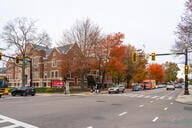You have /5 articles left.
Sign up for a free account or log in.
The National Collegiate Athletic Association’s Division I men’s basketball tournament surpassed the postseason National Invitation Tournament in terms of prestige decades ago. But when the NCAA messed with the preseason NIT, that was the last straw.
Lawyers for the NCAA and the Metropolitan Intercollegiate Basketball Association, which runs the NIT, were in U.S. District Court in Manhattan Monday for the first day of an antitrust lawsuit that threatens to break the stranglehold the NCAA has on men’s Division I basketball tournaments.
If the jury determines that the NCAA intentionally created a monopoly, then large damages, which are tripled in antitrust cases, may be awarded. “If they show the NIT television rights could have been sold to ESPN for half a billion dollars, then you’re talking $1.5 billion,” said Paul Haagen, a professor at Duke University’s Center for Sports Law and Policy. “It could endanger the NCAA’s ability to regulate the sport, and the damages would cripple the organization.”
According to the complaint, originally filed in 2001, the NIT, which was once the dominant postseason tournament in men’s basketball, has been all but gutted because of the NCAA’s anticompetitive measures. In 1982, the NCAA adopted a “commitment to participate” rule that requires teams at any of its more than 1,000 member institutions to compete only in the NCAA postseason tournament in their sport if they are invited. That rule, combined with the NCAA tournament’s expansion from 25 teams before 1975 to 65 today, gave the NIT only left-overs, according to the complaint.
In 1999, the NCAA signed its current $6.2 billion, 11-year contract with CBS for television rights to its tournament -- a sum that constitutes 90 percent of the NCAA’s annual revenue. In order to survive, the Metropolitan basketball association, which is made up of five New York colleges, created the Preseason NIT, a small tournament before the regular season. At the time, the NCAA allowed member institutions to play in the Preseason NIT without having the games count against the total number allowed for a season. The popularity of the Preseason NIT grew, and in April 2000 the Metropolitan association signed a contract with ESPN through 2009-10 that it expected to generate more than $24 million in revenue.
Later in 2000, however, the NCAA gave initial approval to a rule aimed at counting the games played in the Preseason NIT toward a college’s season total. According to the complaint, no serious team would play in the Preseason NIT tournament because it would be impossible for them to schedule a specific number of games for the remainder of their season without knowing how many Preseason NIT games they would play before being eliminated. Under the proposal, end-of-the-year conference tournaments, which are approved by the NCAA, would still not count toward the total number of allowed games.
The proposal was tabled, but, the complaint says, it demonstrates the NCAA’s anticompetitive behavior. Now the jury will have to determine whether the NCAA was simply creating a better product, or systematically exterminating the competition.
The judge has already given the jury its first task, and one that experts said is pivotal: to define the “relevant market” for the antitrust case. According to Rick Karcher, director of the Center for Law and Sports at Florida Coastal School of Law in Jacksonville, MIBA hopes the jury will define the relevant competitors as just the NCAA and NIT tournaments. The NCAA, meanwhile, will seek to place its tournament among many other sporting events, such as the World Series, the Super Bowl, and the Olympics. “If the jury decides it’s a broad market,” said Karcher, “the NCAA can argue that the NIT doesn’t even compete on that level.” He added that MIBA may counter that the NCAA only got to that level because of the commitment-to-participate rule.
But NCAA officials don’t buy it.
“If you look at when NCAA attendance skyrocketed in the mid-1980s,” said Bob Williams, an NCAA spokesman, “it wasn’t at the expense of NIT attendance.” He added that fans recognize the winner of the NCAA tournament as the true national champion. Experts said that the NCAA could argue that consumers, for whom antitrust laws exist, would be hurt the most if men’s college basketball becomes like professional boxing, with multiple governing bodies and champions.
Williams said that not a single member institution has asked to change the commitment-to-participate rule, and added that it is an important protection for less visible sports, like wrestling and lacrosse. The rule covers all 88 championships in 23 NCAA sports. “Without member participation, if other tournaments come around, these smaller sports will get diluted,” he said.
Some experts said the lawsuit may result in some sort of settlement that would allow teams to participate in both tournaments, or would restrict the number of teams the NCAA tournament could stake a claim to exclusively (thereby increasing the number eligible to play in the NIT).
All of the experts interviewed said that antitrust laws are difficult to interpret -- even more so when it comes to sports. “Normally we want the marketplace to control competition,” said Haagen, who said he thinks the NCAA should be able to defend the commitment-to-participate rule on the grounds that it created a superior product that the association expanded to include institutions that wanted in. “In sports, you need organizations to control the competition and enforce rules, so the laws fit uncomfortably.”
Predicting the outcome of the NCAA tournament is an activity that now sweeps the nation every March. As for predicting the outcome for the NCAA tournament in this case, “when you get an antitrust case of this complexity in front of a jury,” said Gary Roberts, director of the Tulane University Law School’s sports law program, “you might as well go to Vegas and play craps.”




